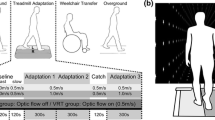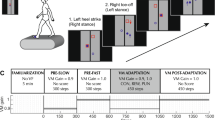Abstract
We investigated the influence of vestibular (caloric ear irrigation) and visual (optokinetic) stimulation on slow and fast split-belt walking. The velocity of one belt was fixed (1.5 or 5.0–6.0 km/h) and subjects (N = 8 for vestibular and N = 6 for visual experiments) were asked to adjust the velocity of the other belt to a level at which they perceived the velocity of both the belts as equal. Throughout all experiments, subjects bimanually held on to the space-fixed handles along the treadmill, which provided haptic information on body orientation. While the optokinetic stimulus (displayed on face-mounted virtual reality goggles) had no effect on belt velocity adjustments compared to control trials, cold-water ear irrigation during slow (but not fast) walking effectively influenced belt velocity adjustments in seven of eight subjects. Only two of these subjects decreased the velocity of the ipsilateral belt, consistent with the ipsilateral turning toward the irrigated ear in the Fukuda stepping test. The other five subjects, however, increased the velocity of the ipsilateral belt. A straight-ahead sense mechanism can explain both decreased and increased velocity adjustments. Subjects decrease or increase ipsilateral belt velocity depending on whether the vestibular stimulus is interpreted as an indicator of the straight-ahead direction (decreased velocity) or as an error signal relative to the straight-ahead direction provided by the haptic input from the space-fixed handles along the treadmill (increased velocity). The missing effect during fast walking corroborates the findings by others that the influence of vestibular tone asymmetry on locomotion decreases at higher gait velocities.





Similar content being viewed by others
References
Bortolami SB, DiZio P, Rabin E, Lackner JR (2003) Analysis of human postural responses to recoverable falls. Exp Brain Res 151:387–404
Brandt T, Strupp M, Benson J (1999) You are better off running than walking with acute vestibulopathy. Lancet 354:746
Dietz V, Colombo G, Jensen L (1994a) Locomotor activity in spinal man. Lancet 344:1260–1263
Dietz V, Zijlstra W, Duysens J (1994b) Human neuronal interlimb coordination during split-belt locomotion. Exp Brain Res 101:513–520
Dietz V, Baaken B, Colombo G (2001) Proprioceptive input overrides vestibulo-spinal drive during human locomotion. Neuroreport 12:2743–2746
Fukuda T (1959) The stepping test: two phases of the labyrinthine reflex. Acta Otolaryngol 50:95–108
Holden M, Ventura J, Lackner JR (1994) Stabilization of posture by precision contact of the index finger. J Vestib Res 4:285–301
Jahn K, Strupp M, Schneider E, Dieterich M, Brandt T (2000) Differential effects of vestibular stimulation on walking and running. Neuroreport 11:1745–1748
Jahn K, Strupp M, Schneider E, Dieterich M, Brandt T (2001) Visually induced gait deviations during different locomotion speeds. Exp Brain Res 141:370–374
Jahn K, Strupp M, Krafczyk S, Schuler O, Glasauer S, Brandt T (2002) Suppression of eye movements improves balance. Brain 125:2005–2011
Jeka JJ, Lackner JR (1994) Fingertip contact influences human postural control. Exp Brain Res 100:495–502
Jensen L, Prokop T, Dietz V (1998) Adaptational effects during human split-belt walking: influence of afferent input. Exp Brain Res 118:126–130
Karnath HO, Sievering D, Fetter M (1994) The interactive contribution of neck muscle proprioception and vestibular stimulation to subjective “straight ahead” orientation in man. Exp Brain Res 101:140–146
Peitersen E (1974) Measurement of vestibulo-spinal responses in man. In: Kornhuber HH (ed) Vestibular system, part 2: psychophysics, applied aspects and general interpretations. Springer, Berlin pp 267–280
Prokop T, Berger W, Zijlstra W, Dietz V (1995) Adaptational and learning processes during human split-belt locomotion: interaction between central mechanisms and afferent input. Exp Brain Res 106:449–456
Schmal F, Kunz R, Stoll W (2000) The localization of an imaginary target under the influence of caloric vestibular stimulation in healthy adults. Eur Arch Otorhinolaryngol 257:473–479
Waespe W, Henn V (1977) Neuronal activity in the vestibular nuclei of the alert monkey during vestibular and optokinetic stimulation. Exp Brain Res 27:523–538
Acknowledgments
Supported by Swiss National Science Foundation (#3200B0-105434, D. Straumann; #3200B0-105324, V. Dietz), Koetser Foundation for Brain Research, Zurich, Switzerland, and the Center of Integrative Human Physiology, University of Zurich, Switzerland. We thank one of the reviewers for pointing out the similarity between haptic and visual influences on the vestibular system.
Author information
Authors and Affiliations
Corresponding author
Rights and permissions
About this article
Cite this article
Marques, B., Colombo, G., Müller, R. et al. Influence of vestibular and visual stimulation on split-belt walking. Exp Brain Res 183, 457–463 (2007). https://doi.org/10.1007/s00221-007-1063-4
Received:
Accepted:
Published:
Issue Date:
DOI: https://doi.org/10.1007/s00221-007-1063-4




